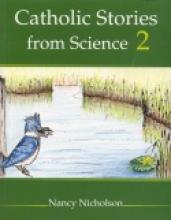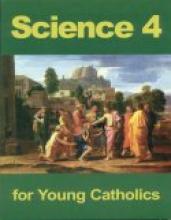Science Elementary - Text
Catholic Stories from Science 2
This book offers thirty-six stories about God's amazing world that very nicely brings science back to its creator and helps children make connections between faith and reason. We've had the earlier edition of this book for a number of years and I have found many tidbits about nature that were new and very interesting to me - especially information about why God made things the way that he did and what is good and useful about his creation.
This new edition includes many new stories and looks more like a grade school workbook - in size and appearance as well as having space for the students to answer the chapter questions right in the book. In addition to the Catholic content I really like this book because 1. it is loaded with interesting content, 2. it is written in an appealing story-like format, 3. it is not "dumbed-down" or written in a condescending tone like so many textbooks. Here's a brief excerpt to give you a sense of the style and content:
"God has a similar system for supplying water to places that don't get much rain in the summer. Instead of a freezer, God uses tall, snow-covered mountains to store up icy snow. In some mountain ranges, like the Rocky Mountains that stretch north and south across Canada and the United States, peaks often receive thirty or forty feet of snow each year. That is nearly enough snow to bury a Ferris wheel! Even after winter has passed, the cool mountain air allows the snow to melt very slowly. Melting snow slips into creeks and rivers that carry needed water to farms and cities far away. Some of those farms and cities don't get much rain in the summer. Some of them don't even have snow in the winter. But the people who live there are happy to drink and swim in the water that came from God's faraway frozen mountains." (from "Merciful Rain" pgs. 59-61)
Click here to read more about Catholic Heritage Curricula's 2nd grade science program
This title was donated for review by Catholic Heritage Curricula
Science 4 for Young Catholics
This 4th grade science textbook is nicely laid out and easy to use. Each chapter begins with a brief biography of a famous Catholic scientist, like Copernicus, Mendel and Pasteur, followed by four literal comprehension questions. The goals of the chapter and an outline are also provided at the beginning of each chapter. Interspersed among the text of the chapters are experiments, activities, and review questions. There are also review study pages at the end of the chapter.
Since it is a Catholic text, the author inserts things to think about which are distinctly Christian. For example, in the chapter about plants, the text offers an explanation of the plant dying to release a seed. There is a picture of a Crucifix on the page and an accompanying caption explains, " . . .a flower dying to produce a seed reminds us of how Jesus suffered and died in order that we might have new life."
The topics covered in this course are The Heavens; The Earth, Moon and Space; Oceans, Weather and Climate; Water and Material Things; Machines; Living Things; The Wonder of Man; and Health. Many states require a health component and this last chapter handily takes care of that requirement.
The topics are arranged in the order of creation, which is great for religion, but not necessarily good for the study of science. If done that way, the student starts with things which are least known to him (the heavens), instead of those things which are most known. However, most secular science texts also start with things least known, like cells. A significant drawback to the text is that there are few if any true "thinking" questions. The questions for review are all explicitly literal comprehension. Even the experiments and activities do not ask the student to reflect about what he has observed or to draw conclusions. That seems to leave out a very important element in the study of science.
If supplemented with discussion and hands on activities, this could be a useful text because of the information it provides. The chapters do not rely or build upon one another, so you could teach the topics in any order you choose.
Although there are many lovely illustrations in this book, I found the cheesy illustrations (such as a cartoonish picture of a sun with sunglasses in the astronomy section) annoying and in conflict with how I want my children to learn to love science. (A.V.H.)



